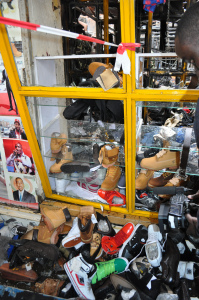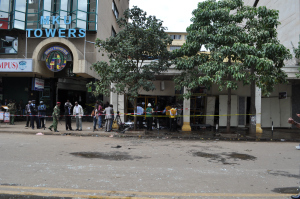Nairobi Blast – Looking for Answers
The problem with terror is that it tends to trample on truth.
On Monday, an explosion ripped through a retail mall full of small stalls selling shoes and T-shirts in Nairobi’s Central Business District. More than 30 people were injured and some of those are still in hospital.
By the time I got there, the fire that had gutted the building was out, the injured people had been taken away and the emergency crews were beginning to tidy up their firehoses. A steady stream of suited officials and smartly uniformed, cap-wearing police officers gingerly made their way through the broken glass and burnt stalls for a tour and then a few words for the many, many cameras.
At first, most officials at the scene blamed an electrical fault. Or at the very least said it was too early to tell but that an electrical fault could have caused the blast.
“The initial investigation does not actually indicate anything to do with terrorism. It does not indicate anything to do with a grenade attack or anything like that. It’s actually pointing towards some kind of electrical fault and that is what we are treating it as at this particular moment, but of course the investigation is still ongoing to find out what exactly caused the blast,” said Jamleck Kamau, Nairobi metropolitan development minister.
He reassured Nairobians that the government was doing everything it could to make sure the city was safe, and that CCTV cameras would soon be installed. (Capital FM says the 11 billion-shilling project will kick off next week with the advertisement of an international tender).
Police Commissioner Mathew Iteere also initially blamed an electrical fault, although Kenya Power (formerly Kenya Power and Lighting Company, or, as the wags would have it, Kenya Please Light Candles) quickly issued a statement saying there was no way it could have been an electrical fault as there was no ground-mounted transformer at the site.
Now, police and officials have said it was likely a bomb, possibly a fertilizer bomb. Some witnesses have said a bearded man left a bag at one of the stalls moments before the blast.
Of course, fingers are pointing at the Somali Islamist group al-Shabaab. But there has been no claim of responsibility so far, which is odd. You’d think a group whose avowed aim is to cause terror and fear would jump at the opportunity to lay claim to an explosion in the heart of Nairobi at lunchtime. Especially since they threatened to bring the “flames of war” to the Kenyan capital after the country sent its soldiers across the border last October.
Police have now issued a photo of a man they want to question, naming him as Emrah Erdogan. He is believed to be either Turkish or German and may be linked to al-Shabaab. But not necessarily to Monday’s blast. Whatever it was. They have two other suspects they want to question for the explosion.
You do have to wonder if the string of low-level attacks in Nairobi can all be attributed to al-Shabaab. Of course, the attacks could be carried out by so-called “lone wolf sympathizers”. But maybe not.
At the end of April, a grenade was thrown into a church in Nairobi’s Ngara area. One person was killed and at least 15 injured. Police said afterwards that it was not a terror attack, but that it might have been the result of a long-running land dispute. But then later, Iteere said that the attacker was “a known terrorist”. And again a photo was circulated.
We are already in an election year in Kenya. At the very least, that means heightened tensions, raised stakes and a reason to suspect motives. And having a bad guy like al-Shabaab on the scene may offer others a figleaf for their own actions, be they personal, political, economic.
On the letters page of the Daily Nation today, Omondi Ocholla Rampell writes: “It has become easy for those who take such attacks at face value to attribute each of them to al-Shabaab militants. However, I am convinced that information from the intelligence community, which may not be public at the moment, could point to other internal actors who may not necessarily be connected to known terror organizations.”’
I don’t know why Ocholla Rampell, a political scientist, is convinced or what information he may have, but he does make some valid points. At the very least, we should know the extent of the unknowns, be they known unknowns or unknown unknowns, to paraphrase Rumsfeld.
Ocholla Rampell gives a handy list of where to start:
“Kenya must, therefore, take a hard look at the pattern of the attacks targeting civilians, their nature, explosives used and the identity of those behind the acts. We must also ask tough questions as to who could be keen on creating a breakdown in law and order in the country, including how such individuals or groups are likely to benefit from a temporary state of lawlessness.”
I’m not saying there must necessarily be a conspiracy theory. Or theories. But it’s worth remembering, I guess, that reflex responses may not be right. It’s not always THE bad guy. It may be the other bad guy, the one that you didn’t pay much attention to as the movie rolled along.







